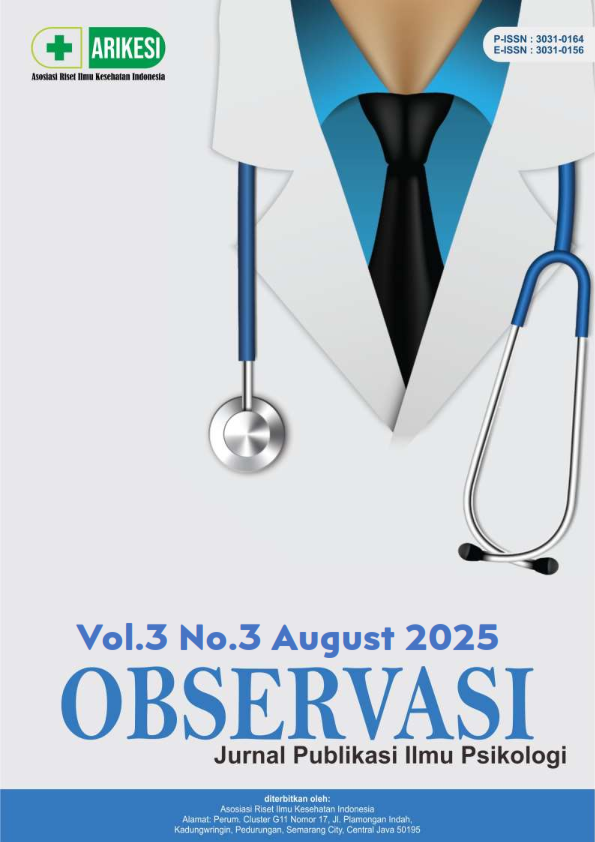Makan Tanpa Distraksi: Mindfulness sebagai Kunci Aktivasi PFC dalam Pengendalian Impuls
DOI:
https://doi.org/10.61132/observasi.v3i3.1549Keywords:
Mindfulness, Eating Behavior, Prefrontal Cortex, Distraction while eating, Self-RegulationAbstract
This study aims to analyze the role of mindfulness in controlling impulses while eating through practice.mindful eating. By using quantitative methods and designone group pretest-posttest, the study involved five participants who had a habit of eating with multitasking. The intervention was carried out for seven days, with measurements usingMindful Attention Awareness Scale(MAAS) and daily reflective questions. Results showed an increase in mindfulness scores from an average of 8.2 to 8.8 after the intervention, although there was variation between individuals. These results indicate thatmindful eatingcan improve self-control and strengthen activityprefrontal cortex (PFC). This study has scientific contributions in the development of mindfulness-based healthy behavior interventions and recommendations for further research.
Downloads
References
Aini, M. H. (2024). Dampak Meditasi dan Mindfulness terhadap Struktur dan Fungsi Otak yang Berhubungan dengan Pengurangan Kecemasan. Jurnal Ilmiah Nusantara, 1(4), 250–254.
Britta K. Hölzel, Carmody, J., Mark Vangel, Christina Congleton, Sita M. Yerramsetti, Tim Gard, & Sara W. Lazar. (2011). Mindfulness practice leads to increases in regional brain gray matter density. https://doi.org/https://doi.org/10.1016/j.pscychresns.2010.08.006
Elfa, K., Warsanto, P., & Sulastri, A. (2025). LITERATUR REVIEW : NEUROSAINS DALAM PENDIDIKAN ; MEMAHAMI MEKANISME OTAK DAN KONTROL DIRI REMAJA. 9, 129–139.
Hölzel, B. K., Lazar, S. W., Gard, T., Schuman-Olivier, Z., Vago, D. R., & Ott, U. (2011). How does mindfulness meditation work? Proposing mechanisms of action from a conceptual and neural perspective. Perspectives on Psychological Science, 6(6), 537–559. https://doi.org/10.1177/1745691611419671
Kabat-Zinn, J. (2003). Mindfulness-based interventions in context: Past, present, and future. Clinical Psychology: Science and Practice, 10(2), 144–156. https://doi.org/10.1093/clipsy/bpg016
Maharani, T. (2024). Hubungan Mindful Eating dan Tingkat Stres dengan Status Gizi pada Siswa SMA Global Persada Mandiri School. 3(September), 199–208.
Mason, A. E., Epel, E. S., Kristeller, J., Moran, P. J., Dallman, M., Lusting, R. H., Acree, M., Bacchetti, P., Laraia, B. A., Hecht, F. M., Daubenmier, J., & J.J., D. (2016). Effects of a randomized controlled trial of a mindfulness-based intervention on cardiovascular responses to social evaluative threat in obese adults. Journal of Behavioral Medicine, 39(2), 201–213. https://doi.org/10.1007/s10865-015-9692-8.Effects
Mert Biberoğlu, F., Güven, S., & Yenipınar, Z. G. (2024). Determining the relationship between physical activity and intuitive eating and mindful eating in university students. International Journal of Agriculture Environment and Food Sciences, 8(2), 301–314. https://doi.org/10.31015/jaefs.2024.2.7
Miladinović, P., & Mitić, A. (2022). Preliminary psychometric investigation of Serbian mindful attention and awareness scale (MAAS) and potential role of mindful attention and awareness in behavioral regulation among students. Engrami, 44(1), 4–21. https://doi.org/10.5937/engrami44-36516
Minari, T. P., de Araújo-Filho, G. M., Tácito, L. H. B., Yugar, L. B. T., Rubio, T. de A., Pires, A. C., Vilela-Martin, J. F., Cosenso-Martin, L. N., Fattori, A., Yugar-Toledo, J. C., & Moreno, H. (2024). Effects of Mindful Eating in Patients with Obesity and Binge Eating Disorder. Nutrients, 16(6), 1–20. https://doi.org/10.3390/nu16060884
Rahman, A. A. (2019). Peran Mindfulness dalam Meningkatkan Behavioral Self Control pada Remaja. Jurnal Ilmu Perilaku, 3(2), 110. https://doi.org/10.25077/jip.3.2.110-117.2019
Rathore, M., Verma, M., Nirwan, M., Trivedi, S., & Pai, V. (2022). Functional Connectivity of Prefrontal Cortex in Various Meditation Techniques – A Mini-Review. International Journal of Yoga, 15(3), 187–194. https://doi.org/10.4103/ijoy.ijoy_88_22
Studi, P., & Islam, P. (2025). HUBUNGAN MINDFUL EATING DENGAN PERILAKU DIET PADA PENDERITA DIABETES MELITUS TIPE 2 UNIVERSITAS ISLAM NEGERI RADEN INTAN LAMPUNG 1446 H / 2025 M HUBUNGAN MINDFUL EATING DENGAN PERILAKU DIET PADA PENDERITA DIABETES MELITUS TIPE 2 1446 H / 2025 M.
Tang, Y.-Y., Hölzel, B. K., & Michael I. Posner. (2015). The neuroscience of mindfulness meditation. https://doi.org/https://doi.org/10.1038/nrn3916
Downloads
Published
How to Cite
Issue
Section
License
Copyright (c) 2025 Observasi : Jurnal Publikasi Ilmu Psikologi

This work is licensed under a Creative Commons Attribution-ShareAlike 4.0 International License.





